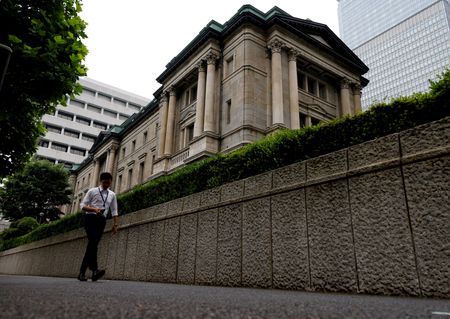By Leika Kihara and Takahiko Wada
TOKYO (Reuters) – The Bank of Japan bought a record $182 billion worth of government bonds in January, data showed on Wednesday, underscoring its resolve to defend its yield cap from attack by investors betting on a near-term interest rate hike.
The massive buying highlights the increasing difficulty the central bank faces in sustaining its yield control policy, as inflation perks up well above its 2% inflation target.
With its heavy-handed intervention drying up bond market liquidity, the BOJ is increasingly relying on a new funds-supply tool to keep the 10-year yield from breaching its 0.50% ceiling.
Some analysts, however, see such steps as a stop-gap effort to buy time until a new BOJ governor, who succeeds incumbent Haruhiko Kuroda in April, begins deliberations to revamp yield curve control (YCC).
“The BOJ is trying all available means to defend YCC but in doing so is increasing, not reducing, distortions in the bond market,” said Naomi Muguruma, senior market economist at Mitsubishi UFJ Morgan Stanley Securities.
“It’s become a widely shared view in the market that YCC won’t be sustained under the new BOJ leadership. It would be a huge surprise if the BOJ doesn’t tweak YCC in April,” she said.
The BOJ’s bond buying in January, at 23.69 trillion yen ($182 billion), was the biggest amount on record and exceeded the previous high of 16.2 trillion yen marked in June 2022, central bank data showed.
Under yield curve control, the BOJ guides short-term interest rates at -0.1% and the 10-year bond yield around 0%.
The BOJ’s decision in December to widen the allowance band around the 10-year yield target heightened market expectations of a near-term rate hike, forcing the bank to ramp up bond buying to defend the newly set 0.5% cap for the 10-year yield.
Under pressure to iron out market distortions caused by its heavy bond buying, the BOJ remodelled in January a funds-supply operation into a tool to prevent yields from rising too much.
On Tuesday, the BOJ pumped five-year loans worth 1 trillion yen against collateral to financial institutions, in its second such operation with the remodelled tool.
While the BOJ has so far offered only two- and five-year loans, the BOJ can offer funds as long as 10 years with the revamped funds-supply operation.
“Depending on market conditions, an offer of long-term funds such as 10-year loans cannot be ruled out,” a source familiar with the BOJ’s thinking said, a view echoed by another source.
While offering such long-term loans will be a fresh sign of the BOJ’s determination to maintain YCC, the impact of the move on bond yields may be short-lived as markets continue to price in the chance of a near-term rate hike, some analysts say.
The 10-year bond yield stood at 0.480% on Wednesday, remaining close to the BOJ’s 0.5% cap.
The government is expected to present its nominees for the new BOJ governor and two deputies to parliament later this month. Kuroda’s term ends on April 8, and that of his two deputies on March 19.
Kuroda chairs his final BOJ policy meeting on March 9-10. His successor’s first meeting will be held on April 27-28 with career central bankers Masayoshi Amamiya and Hiroshi Nakaso seen as strong contenders.
($1 = 130.1800 yen)
(Reporting by Leika Kihara and Takahiko Wada, additional reporting by Kantaro Komiya; Editing by Shri Navaratnam, Uttaresh.V and Christian Schmollinger)

